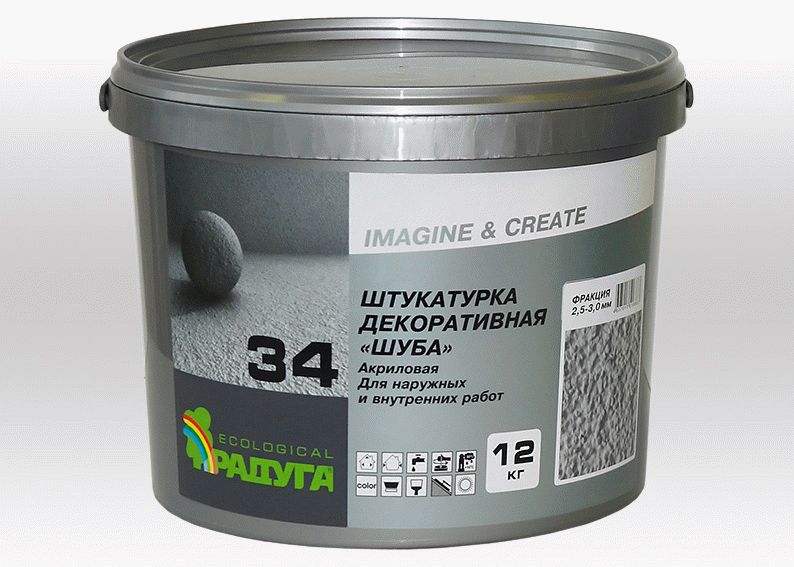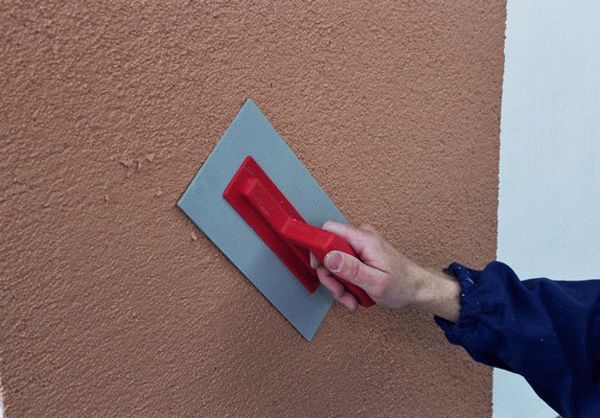Everyone knows what plaster under a fur coat is. This type of decorative coating is often used for exterior decoration of houses. The secret of its popularity lies, perhaps, in the low cost of the components that make up the working mixture, as well as in the relatively simple application technology. Whereas such a cladding looks quite dignified. For those who wish to see their home “dressed” in a traditional fur coat, the article below may be useful, which will tell you how to do it yourself.
In the past, cement-based compositions were used for plastering fur coats. And even now, many builders use them, preferring dry mixes. Such materials are more practical and cheaper than other analogues. However, in this case, the cement completely deprives the finished solution of its elastic properties. Therefore, professional craftsmen are trying today to use acrylic compositions that are sold ready-made and have a number of positive qualities. True, such mixtures cost several times more.
 Finished acrylic plaster "fur coat"
Finished acrylic plaster "fur coat" Often ready-made and dry mixes go on sale already painted. But you can also independently give the material the desired shade with the help of coloring powders or tinting pastes. The original color of the composition is usually white or gray. The first option is suitable for creating pastel colors, the second is for preparing darker compositions. However, there is one caveat here. It will not be possible to dissolve the material in sufficient volume at once, and it is very problematic to give the mixture the necessary shade, preparing the color composition in small batches.
Important! When coloring the composition, you need to try to observe the proportions of the tinting paste so that the next mixing of the components results in the same shade.
For those who do not want to risk guessing tones, there is a safer way - this is painting the surface with facade paint. Here you will no longer have to worry that the finish will turn out to be multi-colored. However, this method is also not the most successful, since when small cracks form, they will be immediately visible.
Solution application methods
Plaster can be applied by various methods, among which there are both completely manual and more advanced ones. Each of them will be discussed below.
Manual ways

Improved methods

On a note! The machine for applying plaster under a fur coat is an excellent option for those who do not have the means to get a compressor. Despite the fact that the work is done by hand, the quality of the finish is practically equal to the option with the use of a compressor. The solution spreads nicely and evenly.
Stages of work
So, the methods of staining and applying the solution have been considered, and it's time to talk about how to make plastering a fur coat with your own hands, disassembling the whole process in stages.

- It all starts with surface preparation, during which you need to clean the base from dust and dirt, and then apply incisions to the wall with a chisel and hammer.
- Next, the surface is primed using a special ready-made composition for this, which is easily applied with a wide brush. The primer improves the adhesion of the base, due to which the plaster coat will adhere more firmly to it.
- After soil treatment, you need to let the surface dry well, and then you can start applying the mixture, having previously determined which solution will be used.
Note: the technology below assumes the use of a cement-sand mortar, which, despite the emergence of new materials, continues to be popular.
- In this case, the plaster is formed from three layers, the first of which is applied and leveled with a conventional trowel. In this case, the solution should have a creamy consistency.
- After the first layer has dried, apply another one of the same, and also allow it to dry.
- At the final stage, the decorative coating is sprayed directly using one of the methods described above.
Points to consider when working
When starting the plastering process, it should be remembered that the optimum air temperature for working with a solution is from +5 to +27 degrees. Not lower and not higher. At the same time, direct rays of the sun should not fall on the raw mixture, which means that another desirable condition is work in cloudy weather. But no precipitation.
Don't skimp on a primer. The entire surface of the building must be carefully treated.
Special powders can be used as coloring agents for the solution:
- to obtain a white color, asbestos or crushed white marble is suitable;
- paint the mixture red - you can use iron ore or manganese;
- coal powder will help to give the composition a black color;
- finely crushed cobalt glass - a means that allows you to prepare a blue-blue composition.

Powders are added to the solution while mixing the cement-sand composition with water.
Now, knowing the technology of applying plaster under a fur coat, those who want to decorate their home with their own hands can only apply the theory in practice.




